MIRABEGRON
- Betanis
- Myrbetriq
- UNII-MVR3JL3B2V
- YM 178
- YM178
Мирабегрон
ميرابيغرون 米拉贝隆
Mirabegron (YM-178, Astellas Pharma), is an orally active, first-in-class selective β₃-adrenoceptor agonist for the symptomatic treatment of overactive bladder (OAB), and has been approved for urinary frequency and urinary incontinence associated with OAB
Mirabegron (YM-178) is the first β3-adrenoceptor agonist that is clinically effective for overactive bladder. Mirabegron (0.3 and 1 mg/kg) inhibits mechanosensitive single-unit afferent activities (SAAs) of Aδ fibers in response to bladder filling. Mirabegron activates the β3 adrenergic receptor in the detrusor muscle in the bladder, which leads to muscle relaxation and an increase in bladder capacity. Mirabegron (YM-178) acts partly as an irreversible or quasi-irreversible metabolism-dependent inhibitor of CYP2D6. Mirabegron at a dose of 3 mg/kg i.v. decreased the frequency of rhythmic bladder contraction induced by intravesical filling with saline without suppressing its amplitude in anesthetized rats. Mirabegron decreases primary bladder afferent activity and bladder microcontractions in rats. Mirabegron (YM-178) also reduced non-micturition bladder contractions in an awake rat model of bladder outlet obstruction.
Mirabegron is a white crystalline powder, not hygroscopic and freely soluble in dimethyl sulfoxide, soluble in methanol and soluble in water between neutral to acidic pH. The chemical name is 2-(2- Amino-1,3-thiazol-4-yl)-N-[4-(2-{[(2R)-2-hydroxy-2- phenylethyl]amino}ethyl)phenyl]acetamide., Mirabegron exhibits stereoisomerism due to the presence of one chiral centre. The R enantiomer has been used in the manufacture of the finished product. The enantiomeric purity is controlled routinely by chiral HPLC-UV. Polymorphism has been observed for the active substance. The polymorphic form α is routinely and consistently produced by the synthetic process and it is used in the manufacture of the finished product…….http://www.ema.europa.eu/docs/en_GB/document_library/EPAR_-_Public_assessment_report/human/002388/WC500137308.pdf
Mirabegron (formerly YM-178, trade name Myrbetriq, Betmiga in Spain) is a drug for the treatment of overactive bladder.[2] It was developed by Astellas Pharma and was approved in the United States in July 2012.[3]
Mirabegron activates the β3 adrenergic receptor in the detrusor muscle in the bladder, which leads to muscle relaxation and an increase in bladder capacity.[4]\
NMR PREDICT
PAPER
http://jocpr.com/vol7-iss4-2015/JCPR-2015-7-4-1473-1478.pdf
Journal of Chemical and Pharmaceutical Research, 2015, 7(4):1473-1478
In the first approach, the introduction of the chiral hydroxyl group was planned at the later stage (Scheme 1). Accordingly, 2-(4-nitrophenyl)ethyl amine 4 was protected as the Boc-derivative 5, followed by the reduction of the nitro group using stannous chloride to furnish corresponding aniline 6. Alternate reducing conditions such as hydrogenation in the presence of 10% Pd-C were also provided the desired 6 in good yield. Amide coupling of the aniline 6 with 2-(2-aminothiazol-4-yl) acetic acid 7 in the presence of EDC, HOBt/DIPEA furnished the desired amide 8. Interestingly, lower reactivity of 2-aminothiazole precluded any self-coupling of 7.
Removal of Boc-group in 8, set the stage for the critical step of introducing the chiral hydroxyl by means of stereocontrolled ring opening of the chiral (R)-styrene epoxide 10. Epoxide opening reaction of 10 was initially attempted with amine 9 in the presence of Et3N in MeOH as the solvent. Alternatively, epoxy opening was also performed under simple isopropanol reflux condition to get the desired 1. The desired product 1 was isolated in 27% yield after purification by column chromatography. This is due to the formation of N-alkylated derivatives of 1 by undesired reaction of 10 with amino functionalities of 1. However, the inefficiency of the epoxide opening reaction precluded a high purity of final product, Mirabegron 1. Since it is not practical to embark on repeated purifications at the last stage (which leads to poor yields), this route was not pursued for further optimization.
13C NMR PREDICT
1H NMR PREDICT
………………
1H NMR PREDICT
13C NMR PREDICT
Cosy predict
……….
Take Mira Veron crude 3.0g, was added thereto, and 30mL of purified water 1.5mL, stirring to dissolve at 80 ℃, slow cooling until the solution clear solution, and incubated at 55 ℃ stirring 1h, white solid precipitate, and slowly cooled to room temperature, filtered and dried under vacuum to give a white Mira Veron product 2.41g, HPLC purity of 99.96%.
mp 138.7 ~ 139.4 ℃. ESI-MS (m / z): 397 [M + H] + , 419 [M + Na] + .
……………….
WO 2015040605
http://www.google.co.in/patents/WO2015040605A1?cl=en
Mirabegron is a beta-3 adrenergic agonist disclosed in U.S. Patent No. 6,346,532. It is chemically designated as 2-(2-aminothiazol-4-yl)-N-[4-[2-{[(2R)-2-hydroxy-2-phenylethyl]amino}ethyl)phenyl]acetamide, having the structure depicted by Formula I.

Formula I
Polymorphs of mirabegron are disclosed in U.S. Patent No. 7,342,117; PCT Publication No. WO 2012/156998; and IP.com Disclosure No. IPCOM000228561D.
U.S. Patent No. 7,342,117 discloses a-Form and β-Form of mirabegron; PCT Publication No. WO 2012/156998 discloses an amorphous form of mirabegron; and IPCOM000228561D discloses crystalline forms of mirabegron and mirabegron monohydrochloride .
Summary of the Invention
The present invention provides a crystalline form of mirabegron, a process for its preparation, a pharmaceutical composition comprising it, and its use for the treatment of overactive bladder.
The crystalline form of mirabegron of the present invention is highly pure and free-flowing. It is stable towards polymorphic conversion and shows little or no variation in dissolution profile.
A first aspect of the present invention provides a crystalline form of mirabegron characterized by an X-ray powder diffraction (XRPD) pattern having peaks at d-spacings of 5.74, 4.41, 4.28, 4.16, and 3.80 A.
A second aspect of the present invention provides a process for the preparation of a crystalline form of mirabegron of Formula I characterized by an XRPD pattern having peaks at d-spacings of 5.74, 4.41, 4.28, 4.16, and 3.80 A

Formula I
comprising desolvation of the mirabegron dimethyl sulphoxide solvate of Formula II.

Formula II
A third aspect of the present invention provides a pharmaceutical composition comprising a crystalline form of mirabegron characterized by an XRPD pattern having peaks at d-spacings of 5.74, 4.41, 4.28, 4.16, and 3.80 A and one or more
pharmaceutically acceptable carriers, diluents, or excipients.
A fourth aspect of the present invention provides use of a crystalline form of mirabegron, characterized by an X-ray powder diffraction having peaks at d-spacings of about 5.74, 4.41, 4.28, 4.16, and 3.80 A, for the treatment of overactive bladder with symptoms of urinary incontinence, urgency, and urinary frequency.
Other objects, features, advantages, and aspects of the present invention will become apparent to those skilled in the art from the description provided herein.
………………..
WO 2015044965
http://www.google.com/patents/WO2015044965A1?cl=en
(R)-2-(2-aminothiazol-4-yl)-4′-[2-[(2-hydroxy-2-phenylethyl)amino]ethyl] acetanilide (henceforth “Mirabegron”) also known as MYRBETRIQ™, has a CAS number of 223673-61-8, a molecular formula of C2iH24N402S and the following.structure:

FORMULA (I)
Mirabegron, an orally active beta-3 “adrenergic receptor agonist is used for the treatment of urinary frequency, urinary incontinence, or urgency associated with overactive bladder.
U.S. Patent No. 6,346,532 (henceforth US’532) discloses Mirabegron of formula (I) or salt and its derivatives and process for the preparation of the same.
Example 41 of US’532 describes preparation of Mirabegron dihydrochloride of formula (la), wherein 4-nitrophenylethylamine hydrochloride of formula (III) is reacted with R-styrene oxide of formula (II) to provide (R)-2-[2′-(4-nitrophenyl)ethyl]amino]-l -phenylethanol of formula (XIV) (Reference example 1). Subsequently amino group of compound of formula (XIV) is protected by the amino protecting groups like tert-butoxycarbonyl to obtain compound of formula (V) (Reference example 2). Nitro group of compound (V) is reduced to amino group to obtain compound of formula (VI) using Palladium-carbon (Reference example 3). The compound of formula (VI) is coupled with compound of formula of (VII) to form amide of formula (VIII). Amino protecting group i.e. tert-butoxycarbonyl, is removed by using hydrogen chloride in ethyl acetate to form dihydrochloride salt of Mirabegron of formula (la) as represented in Scheme I.


Thus, example 41 of US’532 does not discuss or exemplify the process for preparation of Mirabegron free base. Some of the limitations of the above synthetic routes are;
i. The protection and deprotection steps makes the synthesis lengthy and contributes to poor atom economy;
ii. The yields of styrene oxide ring opening are low (20-30 %);
iii. R-styrene oxide employed in the process is expensive and thereby adds to the economics of the process; and
iv. Use of column chromatography for the purification of final compound is not feasible at industrial scale.
US .7,342, 1 17 (henceforth US’ 1 17) discloses two crystalline forms namely, a- and beta (β)-crystalline forms of Mirabegron and the process for its preparation. The process for making Mirabegron as per US’ 1 17 involves reaction of (/?)-mandelic acid of formula (XII) with 4-nitrophenylethylamine hydrochloride of Formula (Ilia) in presence of triethylamine, EDC and HOBt to yield compound of formula (XIII), which is further reacted with borane-tetrahydrofuran solution, 1 , 3-dimethyl-2-imidazolidinone in tetrahydrofuran, to obtain compound of formula (XlVa). Compound of formula (XlVa) was reduced in presence of palladium-carbon under hydrogen atmosphere in methanol to obtain compound of formula (XVa). The compound of formula (XVa) was then reacted with 2-aminothiazole-4-yl-acetic acid (VII) in presence of l-(3-dimethylaminopropyl)-3-ethylcarbodiimide monohydrochloride (EDC.HCI) in acidic medium to obtain Mirabegron of formula (I) as a clear solution (Scheme II). The acidic reaction mass was basified with sodium hydroxide solution to obtain the crystals of Mirabegron of Formula (I), which were filtered and dried. The process according to above always provides β-crystalline form.

The methods of making the a-crystalline form always uses β-crystalline form as a starting material wherein the process comprises dissolving the β-crystals in water and ethanol mixture at 80°C, seeding the solution with a-crystals, filtering and drying to obtain the a-crystalline form of Mirabegron of Formula (I).
Subsequently, patent application WO2012156998 discloses some more processes for making the α-crystalline form by dissolving the Mirabegron solid in a solvent or solvent mixture at elevated temperature, cooling the solution or adding an anti solvent to obtain the Mirabegron of Formula (I)·
Some of the limitations of US’ l 17 are as follows:
i. Process is not user-friendly, as there is difficulty in handling and storing of highly flammable and moisture sensitive reagents such as borane-tetrahydrofuran complex; ii. The disclosed process involves use of l-ethyl-3-(3-dimethylaminoprpyl) carbodiimide HC1 (EDC.HCl) and hydroxybenzotriazole (HOBt) in step- 1 which are expensive;
iii. Process is not cost-efficient as it employs addition of expensive borane-tetrahydrofuran complex and l ,3-dimethyl-2-imidazolidinone reagents in step-2, and catalyst like palladium for nitro reduction in step-3; and
iv. Preparation of a-crystalline form always involve reprocessing of β-crystalline form in separate step, use of seed material, reproducibility, use of limited solvents, which does not result in an industrially feasible process for making the α-crystalline form.
Hence, there is a need for a solution that overcomes the above stated limitations by developing process for preparation of Mirabegron and its α-crystalline form which is simple, reproducible, economic and industrially feasible.
said process comprising;
a) reacting 4-nitrophenylethylamine of formula (III) or its acid addition salt of formula (Ilia) with compound of formula (XII) in presence of a solvent and reagent, optionally in presence of base, and/or catalyst to obtain (ii)-2-hydroxy-N-[2-(4-nitrophenyl)ethyl]-2- phenylacetamide of formula (XIII);

(XII) (Ml) (Ilia)
b) reducing (i?)-2-hydroxy-N-[2-(4-nitrophenyl)ethyl]-2-phenylacetamide of formula (XIII) in presence of reducing agent and a solvent to obtain (i?)-2-[2′-(4- nitrophenyl)ethyl]amino]-l-phenylethanol of formula (XIV), optionally converting it into its acid addition salt of formula (XlVa);

c) reducing (i?)-2-[2′-(4-nitrophenyl)ethyl]amino]-l-phenylethanol of formula (XIV) or its acid addition salt of formula (XlVa) in solvent to obtain (i?)-2-[[2-(4-aminophenyl)ethyl]- amino]-l -phenylethanol of formula (XV) or its acid addition salt of formula (XV a) respectively;

d) reacting compound (i?)-2-[[2-(4-aminophenyl)ethyl]-amino]-l-phenylethanol of formula (XV) or its acid addition salt of formula (XVa) obtained in the step (c) with compound of formula (VII) in the presence of solvent, acid and a condensing agent, optionally in the presence of a catalyst to obtain Mirabegron of formula (I);

and
e) Isolating a-crystalline form of Mirabegron of formula (I) obtained in step (d) and optionally purifying by solvent crystallization.
EXAMPLE 9
Preparation of a-form of crystalline (R)-2-(2-aminothiazol-4-yl)-4′-[2-f(2-hvdroxy-2-phenylethylaminol-ethyn-acetanilide (Mirabegron)
Mirabegron (10 g) and 2-propanol (100 mL) were charged in round bottom flask at 28°C (±2). The solution was heated to reflux temperature to obtain clear solution. To this solution, n-Heptane (200 mL) was added at same temperature to obtain crystals. The obtained crystals were cooled to 28°C (±2). The crystals were filtered, washed with n-Heptane (40 mL) and dried under vacuum at 48°C (±2) for 3 hours to obtain 9.2 g of a form of Mirabegron having PXRD pattern shown in Fig.1 and Infrared spectrum (IR) show in Fig 2.
Yield: 8.5 g (85 %); Purity by HPLC: 99.65 %
Impurities
According to the present invention, Mirabegron prepared according to any of the said processes having impurities comprising a compound of formula (A), compound of formula (B), compound
of formula (C), compound of formula (D), compound of formula (E), compound of formula (F), compound of formula (G), compound of formula (H), compound of formula (I), compound of formula (J), compound of formula (K), compound of formula (L), compound of formula (M), compound of formula (N), compound of formula (O), compound of formula (P), compound of formula (Q), compound of formula (R), compound of formula (S), compound of formula (T), compound of formula (U), compound of formula (V), compound of formula (W), compound of formula (X), and compound of formula (Y).

Compound H

Compound I Compound J

Compound W 
………………….
http://www.google.com/patents/CN104230840A?cl=en
Mira Veron (Mirabegron) in Chinese chemical name: (R) -2- (2- amino-1,3-thiazol-4-yl) -4’_ [2- [(2-hydroxy-2 – phenylethyl) amino] ethyl] phenylacetamide; English chemical name: (R) -2- (2-aminothiazol-4-yl) -4, – [2_ [(2-hydroxy-2-phenylethyl) amino ] ethyl] acetanilide; Molecular formula: C21H24N402 S; molecular weight: 396; CAS registry number: 223673-61-8, Mira Veron chemical structural formula shown below.
[0003] Mira Veron belong aryl ethanolamines β 3 receptor agonists, acting on bladder detrusor smooth muscle β 3 adrenergic receptors, bladder relaxation, promote and increase the storage of urine bladder filling, can effectively reduce the frequency of urination, improve overactive bladder, frequent urination caused by urinary urgency and incontinence, therefore, Mira Veron research synthesis also appears important.
[0004] US6346532B1 (publication date of February 12, 2002) discloses a method for synthesizing Mira Veron, the route is as follows:
This synthesis of nitrobenzene hydrochloride as the raw material, through condensation, protection, reduction, and then condensation deprotected Mira Veron. The process is the first step in a yield of less than 50%, and the resulting product content and chiral purity is low, we need to column chromatography, which severely restricted the massive scale-up.
[0005] Document (… Chem Pharm Bull 58 (4) 533-545 (2000)) reported an improved method for the synthesis of Mira Veron, the route is as follows:
The method uses N- benzyl 2- (4-nitrophenyl) ethylamine as a raw material and R- styrene oxide condensates, then reduction, condensation, debenzylation to give Mira Veron. The first step of the method condensation products can be purified by crystallization, but the reduction of the nitro group with a metal reduction, pollution, can not be large-scale amplification, and the final step off too benzyl byproducts, the yield is low, and this step impurities and more difficult purification, seriously affecting the purity of Mira Veron.
[0006] In addition, US 7982049 B2 (publication date of July 19, 2011) discloses another method of synthesis, synthetic route Mira Veron as follows:
In this method, R- mandelic acid and nitrobenzene hydrochloride or hemisulfate as raw material by EDC condensation, borane, palladium on carbon catalytic hydrogenation, then condensation Mira Veron, however, that Methods exist the following problems: (1) reduction reaction of the second step of borane – tetrahydrofuran solvent amount is too large, a high boiling cosolvent 1,3-dimethyl imidazolidinone difficult to recycle, but also difficult to remove, and the cost of the solvent After the huge cost of treatment, is not conducive to industrial production; (2) reduction of the nitro palladium-carbon catalytic hydrogenation reaction of this step is difficult to obtain high-purity products, and through further study of the present inventors have found that this step will produce more impurities, if the reaction high temperature or pressure, the nitro reduction process will dehydroxylation, CN bond cleavage decomposition impurity production, two of which are difficult to remove impurities in this step and will bring to the next step, and then in Mira Veron finished in generating new impurities.
Example 3, a rice shell drop Eurya synthesis comprises the following steps: Step (1) to the 50L glass reaction vessel was charged with R- mandelic 1.01kg, 4- nitrobenzene hydrochloride 1.4 kg, HOBt 0. 2kg, DMF 6L; control the internal temperature <25 ° C slowly triethylamine 0. 7kg; the addition was complete, the batch was added EDC, plus complete, continue stirring for 1-2 hours; TLC monitoring completion of the reaction ; adding ethyl acetate and 28L 14L water, stirred for 30 minutes, standing layer, the organic phase was lmol / L hydrochloric acid solution 15L wash again, 20% (w / w) aqueous potassium carbonate solution was washed twice (each 15L); The organic phase was dried, suction filtered, and concentrated to give crude product; to give the crude product as a white solid (Intermediate Compound I) was recrystallized from toluene 1. 92kg, 91% yield, content of 99. 6%, ee value of 99%;

Step (2) to cryogenic 50L glass reactor was added 3kg intermediate compound I, tetrahydrofuran 30L, nitrogen system, control the internal temperature 5 ° C, sodium borohydride was added portionwise, and then boron trifluoride ether solution was added dropwise, with sodium borohydride and equivalent of boron trifluoride compound I equivalent of three times the dropwise addition, the reaction was heated to 80 ° C 10 hours; TLC tracking reaction was completed; controlling the internal temperature <5 ° C, methanol was added dropwise 1L, concentrated hydrochloric acid 2L, Bi dropwise, with stirring; for half an hour, concentrated to recover the organic solvent; to the residue was added 30% (w / w) 20L of an aqueous solution of potassium carbonate, 20L ethyl acetate, stirred for half an hour, standing layer; concentrated; the residue 30L of isopropanol was added and heated to 40 ° C stirred solution clear, 1L concentrated hydrochloric acid was dropped, and stirred to room temperature 20-25 ° C, filtration, 60 ° C and drying to obtain a white solid 2. 93kg (intermediate compound II), yield 91%, purity more than 99%, ee greater than 99%;

Step (3) To a 20L hydrogenation reaction vessel was charged with intermediate compound 1. 6kg 11,10% palladium on carbon 100g, methanol, 15L; Maintain a hydrogen pressure billion 5MPa, control the internal temperature 25 ° C, 20 hours; TLC tracking reaction to the raw material disappeared; filtration and concentrated; the residue from methanol / ethyl acetate mixture (by volume methanol / ethyl acetate ratio of 1: 10) crystallization, 60 ° C to give 1. 17 kg dry intermediate compound III, yield 81%; purity greater than 99%, ee greater than 99% ^ H-NMR (DMS0-d6) δ (ppm) = 2 . 75-2.90 (2Η, m), 2.96-3.15 (4H, m), 4.96-5.11 (3H, m), 6.21 (1H, d), 6.53 (2H, d), 6.89 (2H, d), 7.29 -7.43 (5H, m), 8.96 (1 H, br), 9.29 (1H, br.);
step (4) in the reaction vessel was charged with 1. lkg intermediate compound III, 2- aminothiazol-4-acetic acid 0. 65kg, water 16kg; control the internal temperature <25 ° C, the addition of concentrated hydrochloric acid was 0. 4kg, stir in batches to join EDC 0. 784kg, the reaction was stirred at room temperature 20-25 ° C, TLC monitoring of the reaction is complete (about need 1-2 hours); 5L at room temperature was added aqueous sodium hydroxide solution (6% by weight concentration), and stirred for 30 minutes; suction filtered, the filter cake slurried with 10L of water 30 minutes before filtration, drained to obtain a wet product of about 1 . 6kg, crude ethanol water mixtures 25L (10L ethanol, 15L water) and recrystallized, 60 ° C and drying to obtain 1. 10kg Mira Veron white powder in a yield of 75.5%; purity of greater than 99.5 percent, ee of greater than 99%, less than one-hybrid 0.
1% JH-NMR (DMS0-d6) δ (ppm) = 1.61 (1H, s), 2.58-2.65 (4H, m), 2.69-2.80 (2H, m) , 3.46 (2H, s), 4.58 (1H, brs), 5.21 (1H, br), 6.31 (1H, s), 6.88 (2H, s), 7.10 (2H, d), 7.19-7.22 (1H, m ), 7.28-7.33 (4¾ m), 7.50 (2H, d), 9.99 (1H, s).
…………………..
CN 103896872
http://www.google.com/patents/CN103896872A?cl=en
Third, Mira Veron synthesis:
reaction:
in 500mL three-necked flask, 2- (2-aminothiazol-4-yl) acetic acid 17.42g (0.086mol), N, N- dimethylformamide 180mL, then added H0BT15.12g (0.104 mol), was added (R) _2 _ ((4- aminophenyl) amino) phenyl-ethan-l-ol -1_ 20g (0.078mol), was added triethylamine 13.04g (0.13mol), was added portionwise EDCI21. 46g (0.104mol), under magnetic stirring, room temperature for 5h, TLC until the reaction was complete tracking.
After treatment: After the completion of the reaction, the reaction solution was poured into 900mL saturated saline water, and then extracted with 400mL of dichloromethane each time, and extracted three times, each time the organic phase is then washed with 200mL of saturated aqueous sodium carbonate solution, washed three times, each time with distilled water and then 200mL of water, washed three times, the organic phase was dried over anhydrous sodium sulfate, and concentrated under reduced pressure to give a white solid in methylene chloride was distilled off Mira Veron crude, the crude product was recrystallized from methanol solution, wherein the methanol solution of methanol and water, the volume ratio of 10: 4, and recrystallized to give 25.08g, yield 81.0%.
The present embodiment Mira Veron synthesized for testing and structural identification:
mp138 ~ 140 ° C (137 ~ 139 ° C)
[α] 20-18. ~ -22. (CH3OH)
chemical purity HPLC: 99.96%
Optical purity: 97.55ee%
HRMS (ES1-MS, m / z) calcd: for C21H25N4O2S [M + H] + 397.16.Found:. 397.16
1H Mffi (400MHz, DMS0) Sl0.00 (s, lH), 7.50 ( d, J = 8.5Hz, 2H), 7.30 (dd, J = 9.5,5.1Hz, 4H), 7.23 (dd, J = 6.0, 2.7Hz, 1H), 7.12 (d, J = 8.5Hz, 2H), 6.90 (s, 2H), 6.30 (s, 1H), 5.24 (s, 1H), 4.60 (s, 1H), 3.45 (s, 2H), 2.74 (dd, J = 9.8, 3.5Hz, 2H), 2.64 (m, 4H).
13C NMR (101MHz, DMSO) δ 168.69 (s), 168.26 (s), 146.35 (s), 145.03 (s), 137.66 (s), 135.51 (s), 129.24 (s ), 128.38 (s), 127.22 (s), 126.33 (s), 119.46 (s), 103.03 (s), 71.88 (s), 57.94 (s), 51.20 (s), 40.40 (s), 40.20 (s ), 39.99 (s), 39.78 (s), 39.57 (s), 35.77 (s)
1H NMR FIG2
13C NMR FIG3
………….
CN 103193730
http://www.google.com/patents/CN103193730A?cl=en
By and O ° C under nitrogen protection temperature conditions, 7.3g (R) -2- amino _1_ benzeneethanol added 250mL three-necked flask, the stirring was dissolved in 50mL of dichloromethane Mira Veron Intermediate C was added dropwise to the reaction solution to form three-necked flask. Stirred for I hour under nitrogen, with stirring 4.12g of sodium borohydride was added to the reaction mixture. The reaction mixture was stirred (under TC 3 hours to TLC the reaction was complete. The reaction is complete the reaction mixture was added dropwise a saturated aqueous ammonium chloride solution IOmL quenched reaction was washed twice with 40mL of water, the organic phase was separated. The The organic phase at the conditions at 0 ° C was added concentrated sulfuric acid was stirred IOmL until TLC after 0.5 hours the reaction was complete, then was added 20mL of 20% aqueous sodium hydroxide solution to complete the reaction of the organic phase was adjusted to pH 10 and stirred for 15 minutes minutes solution. The organic phase first with 50mL saturated brine I times with IOg anhydrous sodium sulfate and concentrated to give crude product was recrystallized from methanol and water to give 18.7g of the final product Mira Veron purity of 99.33%, chiral purity of 99.01%, a yield of 88.12%.
Mira Veron use randomly selected samples prepared by the synthesis method of the present invention is detected by liquid chromatography.
Test conditions: Instrument: Agilent 1100 HPLC;
Column: Luna C18, 4.6mmX 250mm, 5 μ m;
Column temperature: 25 ° C;
flow rate: 1.0mL / min;
The detection wavelength: 2IOnm;
Injection volume: 5ul;
Mobile phase A: acetonitrile;
Mobile phase B: 0.1% phosphoric acid aqueous solution;
Running time: 40min.
FIG liquid chromatography after detection of the sample shown in Figure 1; results are shown in Table I.
Table 1: The Mira Veron chromatographic analysis sample preparation method of the present invention
……….
http://www.google.co.in/patents/EP1440969A1?cl=en
- Example 4 (Production of the α-form crystal from wet cake of the β-form crystal) :
-
The same procedures as in Example 2 were followed to obtain 23.42 kg of a wet cake of the β-form crystal of (R)-2-(2-aminothiazol-4-yl)-4′-[2-[(2-hydroxy-2-phenylethyl)amino]ethyl]acetanilide from 6.66 kg of (R)-2-[[2-(4-aminophenyl)ethyl]amino]-1-phenylethanol monohydrochloride. This cake was added with and dissolved in 92 L of water and 76 L of ethanol by heating at about 80°C, and the solution was cooled at a rate of about 10°C per hour, to which was then added 8.4 g of the α-form crystal at 55°C. Thereafter, the mixture was cooled to 20°C. A crystal was filtered and dried to obtain 6.56 kg of the α-form crystal of (R)-2-(2-aminothiazol-4-yl)-4′-[2-[(2-hydroxy-2-phenylethyl)amino]ethyl]acetanilide.
-
Powder X-ray diffraction diagram and thermal analysis diagram of the α-form crystal are shown in Fig. 4 and Fig. 5, respectively.
1H-NMR (DMSO-d 6, 500 MHz) δ (ppm) = 1.60 (1H, s), 2.59 to 2.66 (4H, m), 2.68 to 2.80 (2H, m), 3.45 (2H, s), 4.59 (1H, br), 5.21 (1H, br), 6.30 (1H, s), 6.89 (2H, s), 7.11 (2H, d, J = 8.5 Hz), 7.19 to 7.23 (1H, m), 7.27 to 7.33 (4H, m), 7.49 (2H, d, J = 8.5 Hz), 9.99 (1H,s). FAB-MS m/z: 397 (M+H)+.
References
- “mirabegron (Rx) – Myrbetriq”. Medscape Reference. WebMD. Retrieved 17 November 2013.
- Gras, J (2012). “Mirabegron for the treatment of overactive bladder”. Drugs of today (Barcelona, Spain : 1998) 48 (1): 25–32. doi:10.1358/dot.2012.48.1.1738056. PMID 22384458.
- Sacco, E; Bientinesi, R et al. (Apr 2014). “Discovery history and clinical development of mirabegron for the treatment of overactive bladder and urinary incontinence”. Expert Opin Drug Discov9 (4): 433–48. doi:10.1517/17460441.2014.892923. PMID 2455903.
- “New Drug Approvals 2012 – Pt. XIV – Mirabegron (MyrbetriqTM)”. ChEMBL. 5 July 2012. Retrieved 28 September 2012.
- “MYRBETRIQ (mirabegron) tablet, film coated, extended release [Astellas Pharma US, Inc.]”. DailyMed. Astellas Pharma US, Inc. September 2012. Retrieved 17 November 2013.
- “Betmiga 25mg & 50mg prolonged-release tablets”. electronic Medicines Compendium. Astellas Pharma Ltd. 22 February 2013. Retrieved 17 November 2013.
- Cypess, Aaron; Weiner, Lauren; Roberts-Toler, Carla; Elía, Elisa; Kessler, Skyler; Kahn, Peter; English, Jeffrey; Chatman, Kelly; Trauger, Sunia; Doria, Alessandro; Kolodny, Gerald (6 January 2015). “Activation of Human Brown Adipose Tissue by a β3-Adrenergic Receptor Agonist”. Cell Metabolism 21 (1): 33–38. doi:10.1016/j.cmet.2014.12.009. PMID 25565203. Retrieved 26 January 2015.
External links
- Sacco, E.; Bientinesi, R. (2012). “Mirabegron: A review of recent data and its prospects in the management of overactive bladder”. Therapeutic Advances in Urology 4 (6): 315–24. doi:10.1177/1756287212457114. PMC 3491758. PMID 23205058.
 |
|
| Systematic (IUPAC) name | |
|---|---|
|
2-(2-Amino-1,3-thiazol-4-yl)-N-[4-(2-{[(2R)-2-hydroxy-2-phenylethyl]amino}ethyl)phenyl]acetamide
|
|
| Clinical data | |
| Trade names | Myrbetriq (US), Betanis (Japan), Betmiga (EU) |
| Licence data | EMA:Link, US FDA:link |
| Pregnancy category |
|
| Legal status |
|
| Routes of administration |
Oral |
| Pharmacokinetic data | |
| Bioavailability | 29-35%[1] |
| Protein binding | 71%[1] |
| Metabolism | Hepatic via (direct) glucuronidation, amide hydrolysis, and minimal oxidative metabolism in vivo byCYP2D6 and CYP3A4. Some involvement of butylcholinesterase[1] |
| Biological half-life | 50 hours[1] |
| Excretion | Urine (55%), faeces (34%)[1] |
| Identifiers | |
| CAS Registry Number | 223673-61-8 |
| ATC code | G04BD12 |
| PubChem | CID: 9865528 |
| ChemSpider | 8041219 |
| Synonyms | YM-178 |
| Chemical data | |
| Formula | C21H24N4O2S |
| Molecular mass | 396.506 g/mol |
| Patent | Submitted | Granted |
|---|---|---|
| Alpha-form or beta-form crystal of acetanilide derivative [US7342117] | 2005-01-06 | 2008-03-11 |
| Pharmaceutical composition for treating stress incontinence and/or mixed incontinence [US2006004105] | 2006-01-05 | |
| Pharmaceutical composition comprising a beta-3-adrenoceptor agonist and a serotonin and/or norepinephrine reuptake inhibitor Pharmaceutical composition comprising a beta-3-adrenoceptor agonist and a serotonin and/or norepinephrine reuptake inhibitor [US2009012161] | 2005-11-24 | |
| Pharmaceutical composition consisting of a beta-3-adrenoceptor agonist and alpha-agonist [US2005154041] | 2005-07-14 | |
| Pharmaceutical composition consisting of a beta-3-adrenoceptor agonist and an active substance which influences prostaglandin metabolism [US2005119239] | 2005-06-02 | |
| Pharmaceutical Composition For Treating Stress Incontinence And/Or Mixed Incontinence [US2007129435] | 2007-06-07 | |
| Remedy for overactive bladder comprising acetic acid anilide derivative as the active ingredient [US7750029] | 2006-06-01 | 2010-07-06 |
| [alpha]-form or [beta]-form crystal of acetanilide derivative [US7982049] | 2008-09-04 | 2011-07-19 |
| BETA ADRENERGIC RECEPTOR AGONISTS FOR THE TREATMENT OF B-CELL PROLIFERATIVE DISORDERS [US2010009934] | 2010-01-14 | |
| PHARMACEUTICAL COMPOSITION FOR IMPROVING LOWER URINARY TRACT SYMPTOMS [US2010261770] | 2010-10-14 |
|
11 to 16 of 16
|
||
|---|---|---|
| Patent | Submitted | Granted |
| PHARMACEUTICAL COMPOSITION FOR MODIFIED RELEASE [US2010144807] | 2010-06-10 | |
| BENZYLAMINE DERIVATIVE OR PHARMACEUTICALLY ACCEPTABLE ACID ADDITION SALT THEREOF, AND USE THEREOF FOR MEDICAL PURPOSES [US8148427] | 2010-04-22 | 2012-04-03 |
| Pharmaceutical composition containing a beta-3-adrenoceptor agonist and an alpha antagonist and/or a 5-alpha reductase inhibitor [US2005101607] | 2005-05-12 | |
| REMEDY FOR OVERACTIVE BLADDER COMPRISING ACETIC ACID ANILIDE DERIVATIVE AS THE ACTIVE INGREDIENT [US2009093529] | 2009-04-09 | |
| PHARMACEUTICAL COMPOSITION FOR TREATING OVERACTIVE BLADDER [US2010240697] | 2010-09-23 | |
| Pharmaceutical composition comprising beta-3-adrenoceptor-agonists and antimuscarinic agents [US2005261328] | 2005-11-24 | |
| US Patent No | Patent Expiry | patent use |
|---|---|---|
| 6346532 | Oct 15, 2018 | |
| 6562375 | Aug 1, 2020 | |
| 6699503 | Sep 10, 2013 | |
| 7342117 | Nov 4, 2023 | |
| 7750029 | Dec 18, 2023 | U-913 |
| 7982049 | Nov 4, 2023 |
| Exclusivity Code | Exclusivity Date |
|---|---|
| NCE | Jun 28, 2017 |
U-913……….TREATMENT OF OVERACTIVE BLADDER WITH SYMPTOMS OF URGE URINARY INCONTINENCE, URGENCY, AND FREQUENCY
सुकून उतना ही देना प्रभू, जितने से जिंदगी चल जाये। औकात बस इतनी देना, कि औरों का भला हो जाये।
 DRUG APPROVALS BY DR ANTHONY MELVIN CRASTO …..FOR BLOG HOME CLICK HERE
DRUG APPROVALS BY DR ANTHONY MELVIN CRASTO …..FOR BLOG HOME CLICK HERE
Join me on Facebook FACEBOOK
 LIONEL MY SON
LIONEL MY SON
जिंदगी चल जाये।
औकात बस इतनी देना,
कि औरों का भला हो जाये।
/////
//////Mirabegron, Overactive bladder, FDA 2012, ASTELLAS PHARMA, YM-178, Myrbetriq, Betmiga













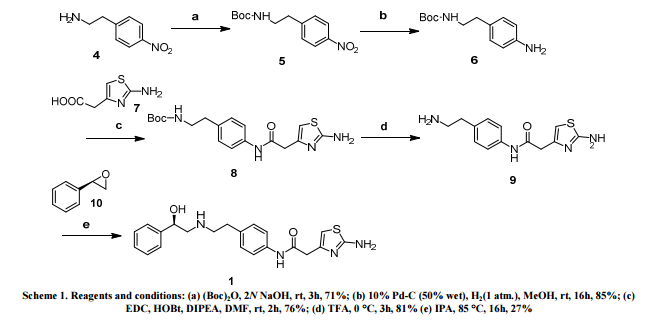
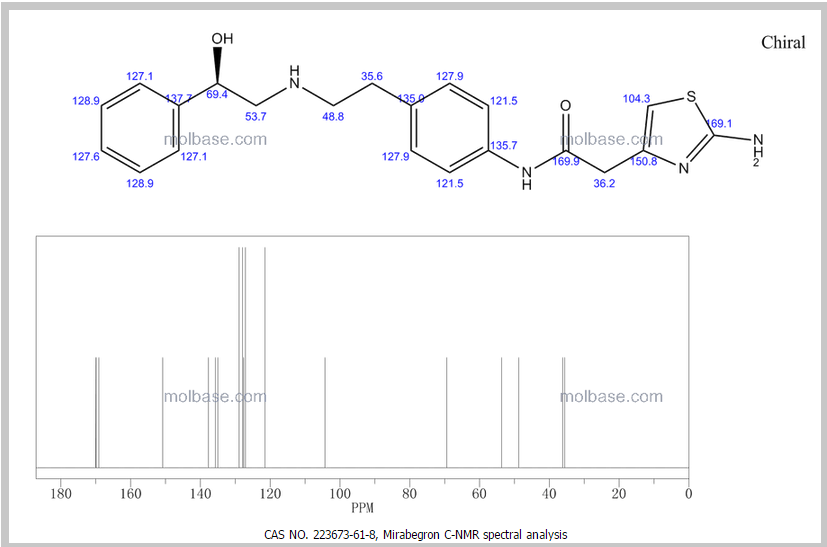
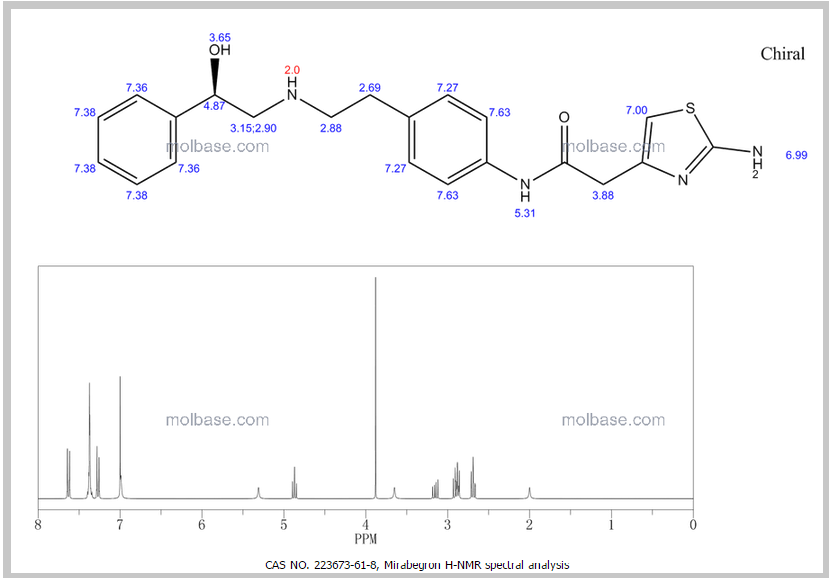
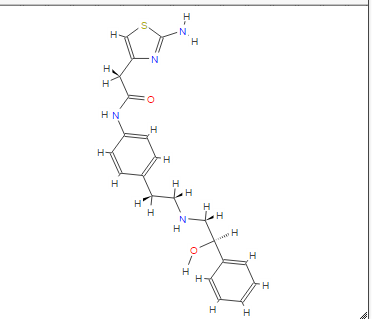

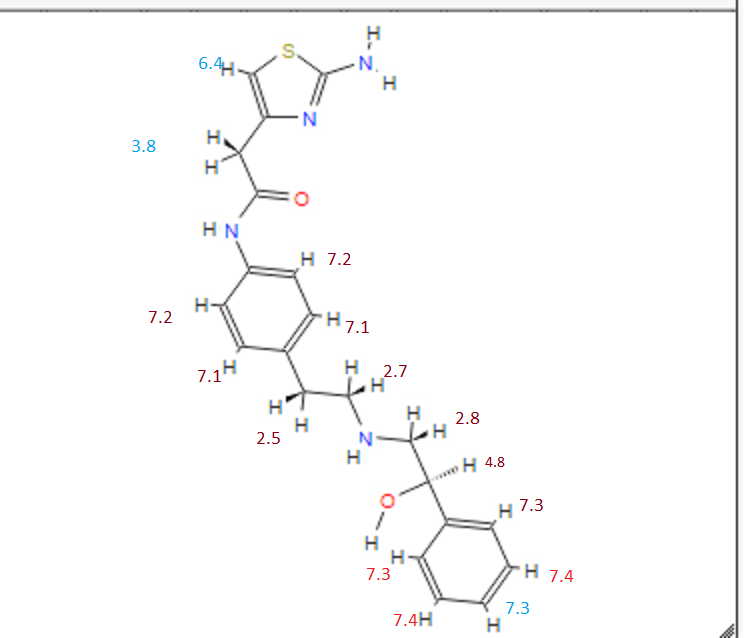
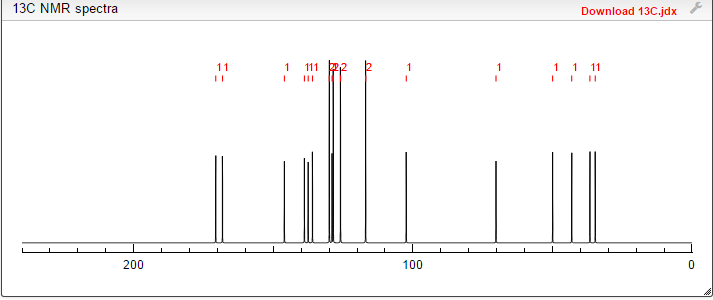
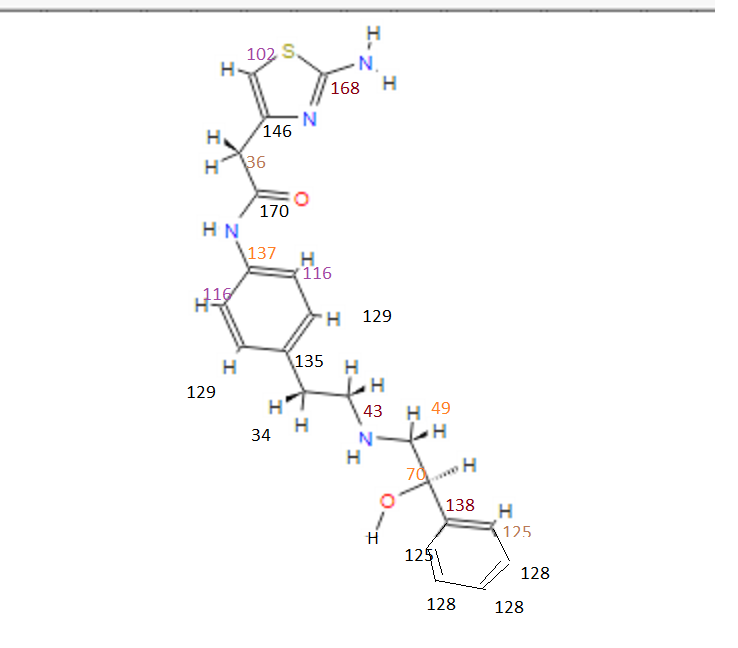
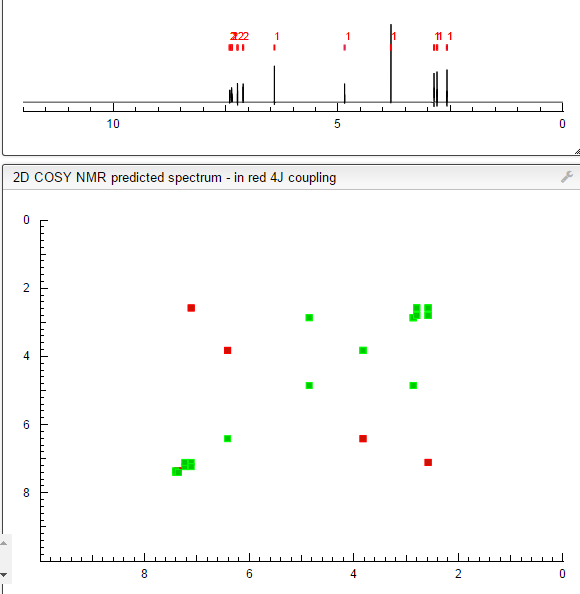















Sorry, the comment form is closed at this time.